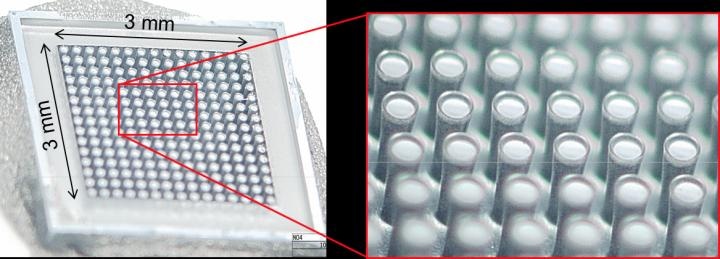May 4 2018
Although it may appear as if batteries come in every size and shape according to one’s imagination, as electronic devices, they become skinnier and tinier without any decrease in their energy and power demands. Hence, they pose challenges to engineers to develop batteries that can be fit into increasingly smaller spaces without affecting the performance.
Scientists from the United States have adopted non-conventional methodologies to work out one probable solution—a robust 3D lithium ion battery with a footprint of the order of one hundred grains of salt. Their study has been reported in the May 3 issue of the Joule journal.
 This photograph depicts the 3D batteries developed by Janet I. Hur, Leland C. Smith, and Bruce Dunn. (Image credit: Hur et al./Joule)
This photograph depicts the 3D batteries developed by Janet I. Hur, Leland C. Smith, and Bruce Dunn. (Image credit: Hur et al./Joule)
“For small sensors, you need to re-design the battery to be like a skyscraper in New York instead of a ranch house in California,” stated Bruce Dunn, senior author of the study, who is a professor of materials science and engineering at the University of California, Los Angeles (UCLA). “That’s what a 3D battery does, and we can use semiconductor processing and a conformal electrolyte to make one that is compatible with the demands of small internet-connected devices.”
How much ever novel be the two-dimensional batteries, they are still limited by the shapes they can take—the basic battery includes a slice of cathode and a slice of anode and packs an ion-conducting electrolyte between the two to complete the circuit. In contrast, a 3D cathode and a 3D anode can be in principle crafted in innumerable ways and they snap together similar to puzzle pieces (though they are still necessarily isolated by a small amount of electrolyte). Dunn’s team has chosen a setup called a “concentric-tube” design in which an array of evenly spaced anode posts are uniformly covered by a thin layer of a photo-patternable polymer electrolyte. The cathode material is filled in the region between the posts.
In spite of this evident simplicity, several scientists could only develop half of a 3D battery, making cathodes and anodes with self-stability, but could not assemble these electrodes into a functional battery. At the same time, almost all the 3D batteries that have been assembled have not been evidently better when compared to ordinary two-dimensional versions. Dunn and Janet Hur and Leland Smith, postdoctoral scholars, solved these difficulties by adopting techniques that are usually used to develop semiconductors and altering them to chisel silicon into a grid of accurately spaced cylinders that they needed for the anode. “That’s something the battery world just does not do,” stated Dunn.
In order to complete the battery, the researchers applied thin layers of electrolyte to the silicon structure and filled in a standard lithium-ion cathode material, using the anode as a mold to make sure that the two halves fit together well. The ensuing battery had an energy density of 5.2 milli-watt-hours per square centimeter, which one of the highest reported for a 3D battery, and occupied a minuscule 0.09 cm2 footprint and withstood 100 cycles of charging and discharging.
However, Dunn cautioned that this specific 3D battery had not yet achieved its full potential, since he believed that he and his colleagues can increase its energy density by further tweaking the battery components and assembly. “Another challenge with batteries is always the packaging,” he added. “You need to seal them up, keep them small, and make sure they function just as well in the real world as in the glovebox.”
The Office of Naval Research supported this study.